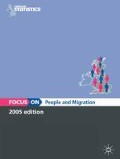Abstract
At the 2001 Census, there were 4.9 million people living in the UK who had been born overseas. They represented a snapshot of an ongoing migration process. Both the timing of immigration and the prevalence of emigration (return or onward) will affect the profile of the foreign-born population and, in particular, the balance between those foreign-born people who are very recent immigrants and those who have been in the country for many years.
Access this chapter
Tax calculation will be finalised at checkout
Purchases are for personal use only
Preview
Unable to display preview. Download preview PDF.
Notes and References
Rendali M S and Ball D J (2004) Immigration, emigration and the ageing of the overseas-born population of the United Kingdom. Population Trends 116, 18–27.
Salt J and McLaughlin G (2002) Global competition for skills: an evaluation of policies’, 201–43 in Migration: Benefiting Australia, Department of Immigration and Multicultural and Indigenous Affairs: Canberra;
Castles S and Miller M J (2003) The Age of Migration: International Population Movements in the Modern World, Guildford Press: New York.
Salt J (2005) Current Trends in International Migration in Europe, Council of Europe: Strasbourg.
The reader interested in individual countries of birth can consult the detailed 2001 Census output tables available on the National Statistics website: www.statistics.gov.uk/census, or refer to the country-by-country analyses (excluding Ireland) in the detailed report of the UK’s foreign-born population by Kyambi S (2005) Beyond Black and White: Mapping New Immigrant Communities, Institute for Public Policy Research, London.
See, for example, Haskey J (1997) Population review: (8) The ethnic minority and foreign-born populations of Great Britain. Population Trends 88, 13–30.
Organisation for Economic Co-operation and Development (2005) Society at a Glance: OECD Social Indicators — 200S Edition, OECD publishing: Paris.
Dumont J-C and Lemaitre G (2005) Counting immigrants and expatriates in OECD countries: A new perspective. OECD Social, Employment and Migration Working Paper 25, www.oed.org
Dumont J-C and Lemaitre G (2005) Table 1 (see note 7).
Owen D (1996) Size, structure and growth of the ethnic minority populations, 80–123 in Coleman D and Salt J (eds) Ethnicity in the 1991 Census: Volume One, Demographic Characteristics of the Ethnic Minority Populations. HMSO: London.
Office for National Statistics (2004) Census 2001 Definitions. TSO: London.
Office for National Statistics (2005) Focus On People and Migration overviews: Overseas Born, www.statistics.gov.uk/focuson/migration
This has been estimated for the 1990s’ period from out-migrants’ responses in the International Passenger Survey to the question on what year they arrived in the UK. These data, when combined with immigrant numbers by country of birth and year as a denominator, allow for the estimation of the proportion of foreign-born immigrants emigrating again within a given number of years following arrival. The methodology is similar to that used in Rendali and Ball (2004: see note 1). The differences are that the immigrant denominator for non-OECD countries includes here total asylum seeker flows for each year (Home Office, various years, Control of Immigration Command Paper series), and that arrivals only in the 1990s are considered.
Bell B D (1997) The performance of immigrants in the United Kingdom: Evidence from the GHS. The Economic Journal 107(441), 333–44.
Wheatley Price S (2001) The employment adjustment of male immigrants in England. Journal of Population Economics 14, 193–220;
Dustmann C, Fabbri F, Preston I and Wadsworth J (2003) The labour market performance of immigrants in the United Kingdom labour market, Home Office Online Report 05/03.
Dobson J and McLaughlin G (2001) International migration to and from the United Kingdom, 1975–1999: consistency, change and implications for the labour market. Population Trends 106, 29–38.
See, for example, Boyle P, Cooke T J, Halfacree K and D Smith (2001) A cross-national comparison of the impact of family migration on women’s employment status. Demography 38(2), 201–13.
Office for National Statistics (2004) Census 2001 Definitions. TSO: London, 67–79.
Among OECD countries, for example, the UK has recently been shown to have simultaneously one of the largest numbers of its tertiary-qualified people resident in other OECD countries and one of the largest numbers of tertiary-qualified people from other OECD countries resident in the UK, see Chart 3 in Dumont and Lemaitre (2005: see note 7).
Leslie D, Drinkwater S, and O’Leary N (1998) Unemployment and earnings among Britain’s ethnic minorities: some signs for optimism. Journal of Ethnic and Migration Studies 24(3), 489–506.
Editor information
Copyright information
© 2005 Crown copyright
About this chapter
Cite this chapter
Rendall, M., Salt, J. (2005). The foreign-born population. In: Chappell, R. (eds) Focus on People and Migration. Focus On. Palgrave Macmillan, London. https://doi.org/10.1007/978-1-349-75096-2_8
Download citation
DOI: https://doi.org/10.1007/978-1-349-75096-2_8
Publisher Name: Palgrave Macmillan, London
Print ISBN: 978-1-4039-9327-4
Online ISBN: 978-1-349-75096-2
eBook Packages: Palgrave Social & Cultural Studies CollectionSocial Sciences (R0)

